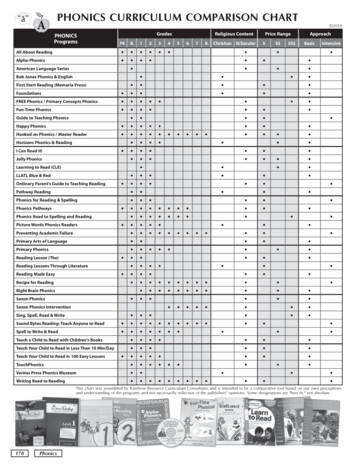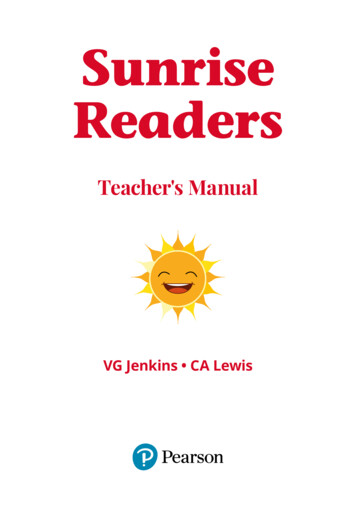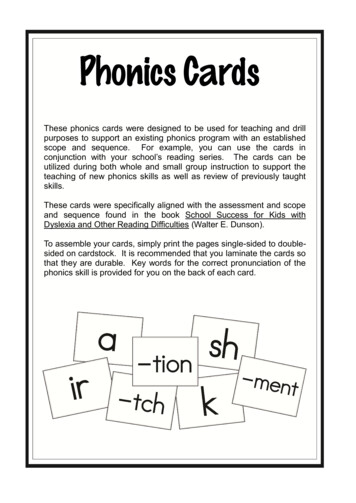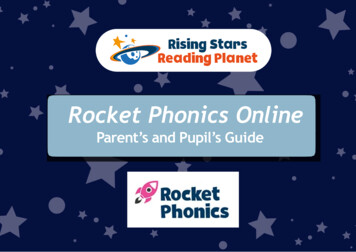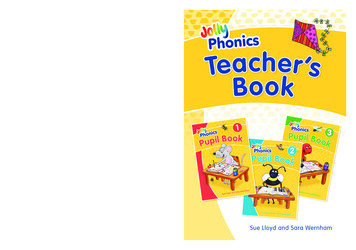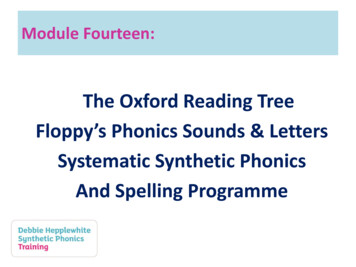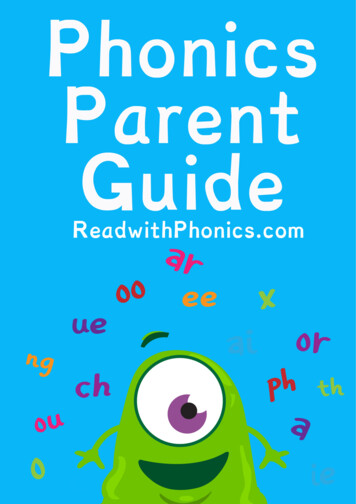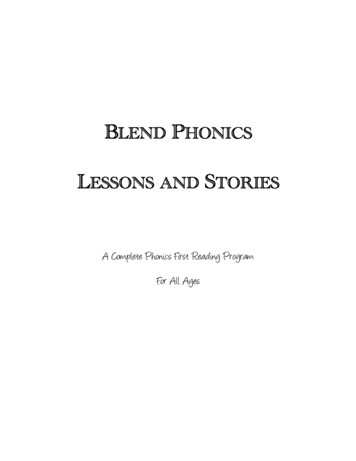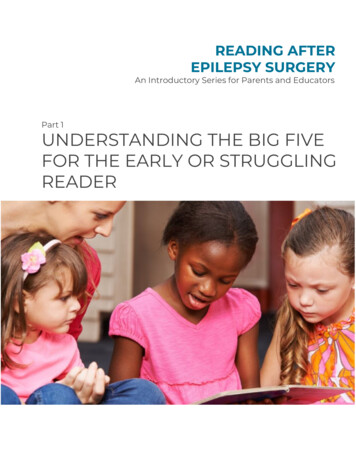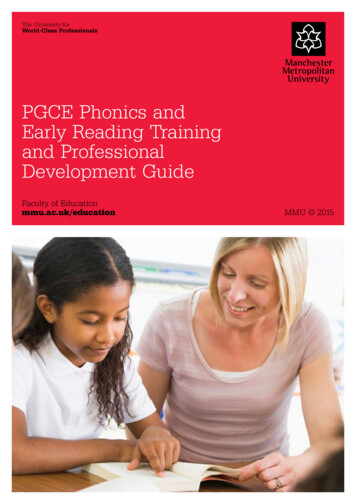
Transcription
The University forWorld-Class ProfessionalsPGCE Phonics andEarly Reading Trainingand ProfessionalDevelopment GuideFaculty of Educationmmu.ac.uk/educationMMU 2015Faculty of Education 1
AcknowledgementsThe work of both Debbie Hepplewhite and Cumbria Universityhave contributed to the development of this handbook.2 mmu.ac.uk
ContentsIntroduction4Phonics First – What is Systematic Synthetic Phonics?5The Simple View of Reading6Meeting the Standards for Qualified Teacher Status7An Overview of Training Relating to Phonics and Early Reading7Early Reading Week Placement Tasks10Key Stage One Placement Tasks12Key Stage Two Placement or Early Years Placement Tasks14RoLOs Lesson Observation One – Delivering a Teacher’s Plan17Lesson Observation Two – Collaborative Planning and Independent Teaching23Lesson Observation Three – Independent Planning and Teaching29Lesson Observation Four – Progression and Formative Assessmen35Review and Reflection41Demonstrating your Understanding of Phonics42Information for Class Teachers and Mentors44Glossary46Overview of Letters and Sounds Phonics Programme48Bibliography and References49Appendices50Faculty of Education 3
IntroductionWe live in a society which is print-rich and which makes increasingly high demands on itsmembers in terms of their literacy skills. Becoming a reader can add to an individual’s senseof human worth and dignity (Meek, 1991), as the reader can access information and engagewith the world around them. Those children who achieve a good start in the first few yearsof reading are very likely to have accelerated progress in their attainment throughout schoolas they engage with the curriculum. In addition, they are also very likely to achieve the skillsvalued by employers (Gibb, 2011). There is no doubt that reading can change lives; it cancreate opportunities which may otherwise be denied. Engaging with texts can deepen theimagination and transform thinking. Reading is a powerful, life-enhancing skill which is theentitlement of every child. No child should be denied access to the full range of learning, tothe joy of engaging with literature and poetry, to fulfilment. Therefore ‘learning to read is afundamental part of a child’s education’ (Gibb, 2011) and tackling reading failure is an urgentpriority for the Department for Education who ‘want to encourage children to experience therewards of reading and develop a lifelong love of books’ (Gibb, 2011a).It is axiomatic that the foundations of reading, whichbegin in the early years of a child’s life, must bewell-established and strong, and that they providestructures on which the cognitive, transformational andinterpretive development demanded by comprehensioncan take place. Rose (2006), in his report entitled‘Independent Review of the Teaching of Early Reading’,made a number of recommendations that haveimpacted on the approach to teaching early reading.The report proposed the ‘Simple View of Reading’ as amodel of the reading process, with its two axes of wordrecognition and language comprehension processes.The model suggests that children must first ‘break thecode and decipher the strange marks [before movingon to] understand the many meanings the wordsconvey’. (Fisher, 2006:3). The report concluded that themost effective approach to the teaching of early readingis through a structured, systematic programme ofsynthetic phonics. This recommendation has resulted inimportant changes in the teaching of reading in nurseryand primary schools in England.It is essential that all students in initial teachertraining are: well-prepared to teach systematic synthetic phonics have the requisite subject knowledge to understandthe alphabetic code on which phonics teachingis based are able to assess and progress learning have an awareness of the various commercialschemes that are available to support teachingand learningThe purpose of this booklet is to focus on the phonicscomponent of learning to read in order to help youto review your knowledge and assess your skills, toreflect on all aspects of your training in the teachingof phonics, both school and university based and todevelop your future practice.It is also intended to focus your attention on TeachingStandards 3 and 6 [DfE 2011, Appendix 1] and tosupport your progress as you move from being a goodteacher of phonics to becoming an outstanding teacher.It is the responsibility of the student teacher to fullyengage with the reflections and complete the taskscontained within this booklet. The booklet should becompleted by your final PDR session when it will becollected in and then verified by your English tutor.4 mmu.ac.uk
Phonics First!What is systematic synthetic phonics?The following information is taken from the report‘The Importance of Phonics: Securing ConfidentReading’ (DfE, 2011:2).‘Synthetic phonics is a method of teaching reading thatensures virtually all children can learn to read quicklyand skillfully. Children are taught the correspondencesbetween sounds (phonemes) and letters. Theyidentify and blend different letter sounds and lettercombinations together (‘synthesise’ them) to makea word - for example, pronouncing each phoneme inshop /sh/-/o/-/p/ and then blending those phonemes toproduce the word. Through this, children take the firstimportant steps in learning to read. They can also usethis knowledge to begin to spell new words they hear.A systematic approach to teaching synthetic phonicsmeans teachers take a planned, thorough approach,teaching children the simplest sounds first andprogressing all the way through to the most complexcombinations of letters.Using a systematic synthetic phonics (SSP) approach,almost all children quickly become confident andindependent readers. They soon move away from themechanics of identifying and blending letter sounds(or ‘decoding’ words) and start reading fluently, evenwhen they come across words they have never heardor seen before.’The Department for Education is strongly encouragingschools to follow phonics programmes to completion sothat children are confident in decoding and encodingmore challenging letter combinations. The Englishprogramme of study in the updated National Curriculum(DfE 2014:4) states“Skilled word reading involves both the speedyworking out of the pronunciation of unfamiliar printedwords (decoding) and the speedy recognition offamiliar printed words. Underpinning both is theunderstanding that the letters on the page representthe sounds in spoken words. This is why phonicsshould be emphasised in the early teaching ofreading to beginners (i.e. unskilled readers) whenthey start school.”Whilst this booklet focuses on phonics, we recognisethat reading is much more than this. As Dombeyargues, we would advocate a balanced approach tothe teaching of reading where“as well as working to master the mechanics of readingthat allow them to lift the words off the page, childrenare encouraged and supported to focus on makingsense of written text, and to see its uses in ordering,enlarging, enjoying and making sense of their lives.It means ensuring that classrooms are filled withinteresting written texts – on screen as well as onpaper– and that children are given rich experiencesof putting these texts to use.” (Dombey et al, 2010: 5)During the course, students will also learn aboutthe significance of reading for pleasure and purpose.Through taught sessions and experiences onplacement students will develop the knowledgeand skills to support pupils to become confidentand enthusiastic readers.Faculty of Education 5
The Simple Viewof ReadingThe Simple View of Reading (Gough and Tumner, 1986)was adopted by Rose (2006) and forms a central part ofthe Government’s view of early reading esPoorLanguageComprehensionProcessesThis matrix is one of several models that aidunderstanding of the reading process. It attemptsto reconcile the interacting processes of wordrecognition and language comprehension.6 mmu.ac.uk
Meeting the Standards forQualified Teacher StatusThe Standards for Qualified Teacher Status were revisedin 2011 (see appendix 1). All students should meet thestandard requirements by the end of their training.The evidence provided in this Professional DevelopmentBooklet will ensure that you are meeting therequirements. The following areas relating to StandardThree – Subject Knowledge are particularly relevant asthey state students should: Have a secure knowledge of the relevant subject(s)and curriculum areas, foster and maintainpupils’ interest in the subject, and addressmisunderstandings Demonstrate a critical understanding of developmentsin the subject and curriculum areas, and promote thevalue of scholarship If teaching early reading, demonstrate a clearunderstanding of systematic synthetic phonicsMore specifically in relation to meeting the standardsin relation to the teaching of early reading, studentsneed to: Know and understand the: recommendations of theRose Review; and the Simple View of Reading and beable to apply this understanding to their teaching ofreading and writing. (The Independent Reviewof the Teaching of Early Reading, Final Report,DfES 2006) Know and understand the alphabetic code Know and understand the criteria for assuringhigh quality phonic work (DfE, 2011) and be ableto recognise how they are metin a range of phonicprogrammes Be able to apply their knowledge and understandingof the Criteria to the teaching and assessment ofphonics using a school’s phonic programme Be able to identify, and provide targeted support for,children making progress both beyond and belowthe expected levelAn Overview of Training Relatingto Phonics and Early ReadingYour training follows a spiral curriculum model in thatknowledge is reviewed and built upon in each taughtsession throughout your course. The combinationof taught sessions, school based training tasks andtime spent in the classroom (lesson observations,lesson planning, delivery and assessment) aims toprovide you with a wealth of opportunities to developyour knowledge and understanding of the readingprocess. This strong link between theory and practicewill prepare you to be an outstanding teacher ofearly reading as you enter the profession as a NewlyQualified Teacher (NQT).Faculty of Education 7
Phonics ObservationsDuring your School Based Training this year you willbe observed four times teaching phonics. Your progresswill be recorded using the phonics RoLOs (Record ofLesson Observation) contained in this booklet. Thisdocument is graded and provides clear statementsabout your performance in each part of the lesson.It has been designed to provide you with a clearindication of how you can progress to grade one –an Outstanding Teacher of Phonics.A range of commercially produced phonics schemes arenow used in Nursery and Primary schools. Take time tofamiliarise yourself with the scheme that your schooluses before planning a session using the university’sphonics planning proforma. Also make sure that you arefamiliar with the alphabetic code.Your supervising teacher/mentor should complete theRoLOs and then set SMART targets with you in orderfor you to achieve your full potential. It is important thatyou evaluate each session critically. You should thinkabout the following: What did the children learn? How do I know? What aspect of the lesson went well? What would I change? How will I progress the children? How has my subject knowledge (content and/orpedagogy) improved?English Sessions Prior toEarly Reading Week PlacementIn preparation for your Early Reading Placement, therewill be an emphasis on language acquisition anddeveloping early literacy. Taught sessions will focus on: The sound system (phonology) of English and howspeech sounds are produced (phonetics) The relationship between spoken sounds and theirwritten representation (phonics) The reading process and the Simple View of Reading The alphabetic code (from a simple to complex code) Articulating pure sounds Segmenting and blending phonemes within words Approaches to teaching phonics Planning an effective multisensory phonics lesson8 mmu.ac.uk
Faculty of Education 9
Early Reading Week Placement Tasks1. Preparing for Reading – EYFS(Nursery and Reception)Find out about how children are being introduced toand encouraged to interact with, books in preparationfor reading. What opportunities are children given todevelop the listening skills inherent in phonologicaldevelopment?To complete this task you will need to: Identify the areas in provision that contribute tothese aspects Talk to staff about how they approach planning forreading and phonics Observe children and staff interacting with books Consider the role of the teacher in supportingchildren’s interactions with textsTo gain maximum understanding from your datacollection, you will need to consider the followingquestions: What opportunities do children have to listen andrespond to stories? What opportunities do children have to join in withsongs, nursery rhymes, poems and music? Have you observed any activities designedspecifically to promote speaking and listening skills? What opportunities do children have to explore andexperiment with sounds and words?Record your findings as a short report for inclusion inyour Early Reading File.2. Explore the provision for readingacross the schoolLook at the provision for and promotion of readingthroughout the school.Make notes and comments on: Availability of library or book areas in school andclassrooms Use made of the areas by children Quality and range of the books and attractivenessof areas Any strategies such as writing book reviews, postersetc. to support engagement Strategies that link with parents to support reading Consideration of language, disability, beliefs, genderand cultural diversity in books10 mmu.ac.uk Reflection of the global dimension or promotion ofintercultural understanding Book weeks and other whole school readingpromotion activities held Other strategies/interventions such as paired readingwith older pupils etc.Record your findings as a short report for inclusion inyour Early Reading File.3. Observe a Phonics Lesson Make notes about the details of the phonics lesson.Consider some of the points below:Prompts for Phonics Lesson Observation What teaching strategy is used when revisitingphonemes, graphemes, GPCs (graphemephoneme correspondences)? What new learning is taking place? Does the teacher use a story, action, song or othermnemonic to help the children remember thenew learning? Note any activities where the children arepractising blending phonemes for word reading. Note any activities where the children arepractising segmenting phonemes for spelling. Note any examples of the teacher correcting amisconception. How is this managed? Consider how the teacher ensures all thechildren are engaged in the lesson. Describe how the teacher differentiates throughtasks, questions or support for different children? Using a University phonics plan proforma,retrospectively complete the plan identifyingwhat the teacher does in each part of the lesson Pay particular attention to the planned activitiesfor each part and how the teacher is makingassessments in relation to the children’sunderstanding Discuss the planning and assessment process withthe teacher at the end of the session and record thatdiscussion in writing Bring your completed phonics plan proforma andrecord of discussion to your University sessionspost-placement
4. Teach a phonics lesson using theteacher’s plan Arrange to teach a phonics lesson working from theteacher’s plan Arrange with the class teacher or mentor to observeyour lesson using the first phonics RoLo in thisbooklet Consider your targets to continue phonicsdevelopment in KS1 block Consider how you can further support yourdevelopment in teaching phonicsEnglish SessionsPrior to SchoolBased TrainingEarly Reading File ContentsEarly Reading Week Preparation for reading Provision for reading across the School Observation of a phonics lessonKey Stage One Placement Understanding the child as a reader Phonics assessment notes Notes from developing comprehension skills and alove of readingKey Stage Two Placement Understanding the child as a reader Notes from developing comprehension skills and alove of reading Example of child’s piece of writing Notes from developing comprehension in guidedreadingDifferences between focus childrenThis part of your training will focus on developingliteracy skills and the child as a reader and a writer.The Simple View model will be revisited and appliedto both reading and writing. Taught sessions will focuson the following: Planning for literacy The writing process and the Simple View of Writing Routines for reading – developing word recognitionand comprehension skills Spelling – decoding and encoding, a reversibleprocess Handwriting as a phonics core skill The teacher as a readerFaculty of Education 11
Key Stage One Placement Tasks1. Understanding the child as a readerSelect a child in your class that you can work with ona regular basis. Initially, you should meet with thischild on a one-to-one basis. You should build a positiverelationship with the child.During your first week in school, establish the child’sattitude towards reading i.e. their reading preferences,whether they think it is important to read or not,their family as readers, what they read at home (e.g.Playstation games, comics etc), do they consider this tobe reading, do they have a favourite book or author, dothey visit the library, do they have books read to themat home, what level on the school’s reading scheme isthe child working at etc? Put your notes from this intoyour Early Reading File.2. Planning and Teaching PhonicslessonsWork with the child in their phonics group. Initially youshould teach a lesson to the group using the teacher’splanning before you are formally observed. Then youmust arrange with your class teacher/mentor to observeyou plan and teach the following phonics sessions:a) With support plan, teach and evaluate a phonicslesson, which your class teacher/mentor will observe(2nd RoLO).b) Plan a single lesson independently, which again yourclass teacher/mentor will observe (3rd RoLO)c) Plan a series of three lessons, one (usually the last) ofwhich is observed (4th RoLO).Planning a series of lessons will ensure that youhave the opportunity to give formative feedback. Itwill support evidence of your awareness of formativeassessment and progression in learning. You may ofcourse teach more phonics lessons than this but youwill receive feedback following each observed lesson.After receiving the feedback you should reflect on yourteaching and the impact on the children’s learning andfill in the evaluation section in this booklet.3. AssessmentYour feedback from your lesson observations shouldconfirm that you are able to make use of formativeassessment to monitor pupils’ progress, set targetsand plan subsequent lessons (QTS Standard 6 b, c).In addition you are required to:12 mmu.ac.uka) Carry out a summative phonics assessment with yourselected child, using the materials provided by thescheme in use at the school. Reflect on the benefitsof such an assessment to both learning and teaching.Put this in your Early Reading File.b) Carry out a diagnostic assessment such as miscueanalysis (Benchmarking). This will enable you toassess other strategies the child may be using toread, and their level of comprehension. Put this inyour Early Reading File.c) In June 2012, the Government introduced a PhonicScreening Check for Year 1 pupils as a requirementfor all maintained schools. It is important that youfamiliarise yourself with summative assessmentsand understand how the information gathered fromthem is used to influence teaching and learning (QTSStandard 6 a, b).Discuss the ‘Phonics Screening Check’ with the LiteracyCo-coordinator or Year 1 teacher. How was it delivered?What training was provided? Were struggling decodersidentified? How will the results be used to improveteaching and learning?Add notes from this discussion to your EarlyReading File.Your class teacher/mentor should confirm that youhave carried out these assessment tasks by signingthe assessment box in the mentor’s section ofthis handbook.4. The Teacher as a ReaderDeveloping comprehension skills and alove of readinga) Using your knowledge of children’s books, selecta non-reading scheme book that you think mightappeal to the child. Read the text with the child.Take it in turns to read and note how the childbehaves with the text. What strategies are theyusing to decode unfamiliar words and make senseof what they read?What questions might you use to support the child’sunderstanding of the text?Does the child approach the reading of this text in adifferent way to the reading scheme books? If so whatare they doing and why do you think this is the case?b) After your final session with the child write a shortparagraph that considers:
How the experience of getting to know a child willinfluence your career as a teacher. The impact of the activity on developing the childas a reader.c) If this is your final placement, reflect on thedifferences between your focus children in the twoplacements. Consider similarities and contrastsbetween the settings. To what extent do youconsider age, resources, reading interest of the childetc. influence the differences that you have noticed?Your notes, impact study and contrast of focus children(if final placement) should be included in your EarlyReading File.Faculty of Education 13
Key Stage Two Placement (Primary) or EarlyYears Placement (Early Years) Tasks1. Understanding the child as a readerSelect a child in your class that you can work with ona regular basis. You should build a positive relationshipwith the child.During your first week in school, establish the child’sattitude towards reading i.e. their reading preferences,whether they think it is important to read or not,their family as readers, what they read at home (e.g.Playstation games, comics etc), do they consider this tobe reading, do they have a favourite book or author, dothey visit the library, do they have books read to them athome, what level on the schools reading scheme is thechild working at etc? Put your notes from this into yourEarly Reading File.2. The Teacher as a ReaderDeveloping comprehension skills anda love of readinga) Using your knowledge of children’s books, select anon-reading scheme book that you think might appealto the child. Read the text with the child. Take it inturns to read and note how the child behaves withthe text. What strategies are they using to decodeunfamiliar words and make sense of what they read?What questions might you use to support the child’sunderstanding of the text?Does the child approach the reading of this text in adifferent way to the reading scheme books? If so whatare they doing and why do you think this is the case?For Early Years placements consider what conceptsabout print the pupil understands. What do they knowabout the language of books and the predictablepatterns of stories?b) After your final session with the child write a shortparagraph that considers: How the experience of getting to know a child willinfluence your career as a teacher. The impact of the activity on developing the child asa reader.c) If this is your final placement, reflect on thedifferences between your focus children in the twoplacements. Consider similarities and contrastsbetween the settings. To what extent do you considerage, resources, reading interest of the child etcinfluence the differences that you have noticed?14 mmu.ac.ukYour notes, impact study and contrast of focus children(if final placement) should be included in your EarlyReading File.3. Phonics for SpellingIn the earlier stages of spelling development childrenrely heavily on phonetic approaches to spelling words.When children spell phonetically they go through thefollowing process: Orally segment a word by identifying all of thephonemes through that spoken word Select the appropriate graphemes to represent eachof the phonemes in the wordIn order to do this effectively they need a goodknowledge of the English alphabetic code(see appendix 3).Select and analyse a child’s piece of writing in terms ofspelling development. Using the spelling chart adaptedfrom Gentry (Appendix 2) note the key features of thechild’s approach to spelling providing examples ofwords from the text. You should record your findingson the next page.3. Developing comprehension inguided readingComprehension or gaining meaning from print is thepurpose and reward of reading. Guided reading offersan important opportunity to teach comprehension skillsand monitor progress through questioning, discussionand activities that interact with the text.For this task, plan and teach a guided reading session.Following this, review the teaching and learningthat took place using Barret’s taxonomy of readingcomprehension (Appendix 4). In response to this, plana further guided reading session incorporating a widerrange of questions and responses. Write up your notesfrom this and add to your Early Reading File.For Early Years PlacementsReading comprehension is considered to be closelylinked with language comprehension. In your earlyyears setting consider how language comprehension isdeveloped and monitored. How is vocabulary taught?How do discussions about texts develop the children’sinterpretation of texts? Consider how these skills forma foundation for later reading success. Write up yournotes from this and add to your Early Reading File.
Phonics for SpellingWhat developmental phase is the child at?What are the next steps for this child?Activity completed on (enter date)Faculty of Education 15
16 mmu.ac.uk
Record of Lesson Observation for the Teachingof Early Reading – Specifically PhonicsLesson One –Delivering a Teacher’s Plan –to be completed in early reading weekThis grid is designed to support students, school basedtutors, mentors and university tutors when observingthe teaching of phonics. It is designed to enable specificfeedback on subject knowledge, planning and teachingto encourage both student and observer to recognisethe impact their teaching has on children’s progressionin learning.After a lesson observation, highlighted sections ofthe grid should identify where the student is currentlyin terms of their practice, together with targets forthe future, which should ensure that they are ableto move themselves on into the higher grades insubsequent lessons.Grading should be made within the context of therequirements for the placement and so by the end ofthe placement, any student is able to achieve a grade 1.Not all statements will apply to all lessons.Faculty of Education 17
18 mmu.ac.ukThere are some opportunities forassessment for learning built into thelesson.The student is able to discusschildren’s learning.The student is aware of assessmentfor learning but does not alwaysprovide appropriate opportunitieswith the lesson.The student is beginning to be able todiscuss individual children’s progress.The student begins to attempt torevisit and review phonemes /learningalready taught.The review, in parts, attempts to bewell paced and active.Children are encouraged to contribute.The lesson contains no opportunity forchildren to review phonemes/learningalready taught.Children are disinterested and fail toengage in an active way in the lesson.Some children are encouraged tocontribute but often do not engagewith the learning.Revisit and ReviewThe student is clear about what thechildren will learn in the lesson.Grade 3Learning objectives are sometimesappropriate but often lack clarityand focus.PlanningGrade 4Children are encouraged to contributeat an appropriate level.The review is generally well pacedand active.The student ensures that childrenrevisit and review phonemes/learningalready taught.The student is able to discuss childrenwho had difficulties and those whoexcelled.There is clear evidence thatassessment for learning opportunitiesare being used in the lesson.The student has planned learningwithin the lesson around anappropriate learning objective.Grade 2Children are encouraged to contributeat their level with appropriatedifferentiation for the less ableand more able. Additional adultscontribute to the learning and/orassessment.The review is consistently well pacedand active.The student consistently ensuresthat children revisit and reviewphonemes/learning already taughtin a systematic way.The student is able to discuss childrenwho had difficulties and those whoexcelled and to identify next stepsfor them.Assessment for learning is used toinform future planning.The student has planned for theprogression of learning within asequence of lessons and can providea justification.Grade 1
Faculty of Education 19The student teaches and models theskills of segmenting and/or blendingas part of the lesson.The student teaches the skills ofsegmenting and/or blending as part ofthe lesson.Some children are clear about whatthey are learning.New learning sometimes introduced.The student fails to teach the skills ofsegmenting and/or blending as part ofthe lesson.Children are unable to identify whatthey are learning.Lesson consists solely of consolidationof prior learning rather thanopportunities for new learning totake place.New learning is generally introduced.Children are generally clear aboutwhat they are learning.The children practise articulatingphonemes and the student addressesany incorrect articulation.The children practise articulatingphonemes.There is no opportunity for thechildren to practise articulatingphonemes.The student generally demonstr
of phonics, both school and university based and to develop your future practice. It is also intended to focus your attention on Teaching Standards 3 and 6 [DfE 2011, Appendix 1] and to support your progress as you move from being a good teacher of phonics to becoming an outstanding teacher.
